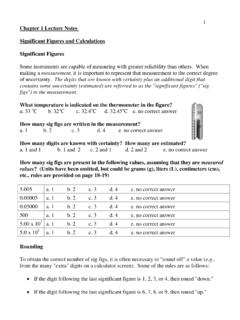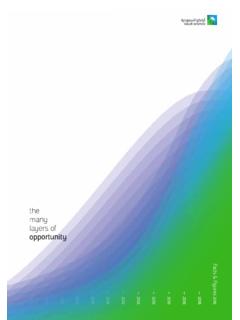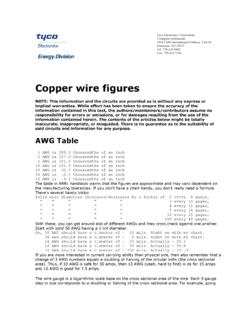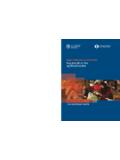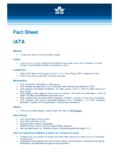Transcription of FDI IN FIGURES - oecd.org
1 FDI IN FIGURES April 2018 FDI drops 18% in 2017 as corporate restructurings decline Global FDI flows decreased by 18% to USD 1 411 billion in 2017 compared to 2016. In the fourth quarter of 2017, FDI flows reached their lowest level since 2013 (USD 280 billion). Inflows to the OECD decreased by 37%, largely driven by decreases in the United Kingdom and the United States from high levels in 2016. Outflows from the OECD decreased by a more modest 4%. In contrast, FDI inflows to non-OECD G20 economies increased by 3% while FDI outflows decreased by 33% as FDI outflows from China declined for the first time since 2005. The United States remained the largest source of FDI worldwide by a long stretch, followed by Japan, China, the United Kingdom, Germany and Canada. China, after being a net outward direct investor for the first time in 2016, became a net inward investor in 2017.
2 Although the majority of OECD countries account for a smaller share of global GDP than they did at the start of the global financial crisis, most still account for a larger share of global inward and outward FDI, indicating that they remain among the more financially integrated economies in the world. In this issue Recent developments FDI in resident SPEs Spotlight on FDI by ultimate investor Spotlight on FDI since the financial crisis Tables of FDI statistics Recent developments In 2017, global FDI flows1 decreased by 18% compared to 2016, to USD 1 411 billion. This represents of global GDP, compared to in 2016 and in 2015, but is comparable to levels recorded between 2012 and 2014. FDI flows into the United States dropped to USD 287 billion after reaching more than USD 450 billion in 2015 and 2016. The high levels in 2015 and 2016 were partly due to financial and corporate restructuring, but it is also likely that the possibility of tax reform decreased incentives to engage in these types of transactions in 2017.
3 The US tax reform will have both immediate and long term impacts on direct investment. For example, it probably boosted FDI flows in 2017 by increasing the amount of earnings US MNEs reinvested in their foreign affiliates as repatriations fell in the fourth quarter in anticipation of more favourable tax treatment in 2018. Looking ahead, this is likely to reduce FDI flows in 2018 as US companies repatriate cash due to the one-time tax on undistributed foreign earnings included in the tax reform. Estimates of the amount of overseas 1 By definition, inward and outward FDI worldwide should be equal, but in practice, there are statistical discrepancies between inward and outward FDI. Unless otherwise specified, references to global FDI flows refer to the average of these two FIGURES .
4 1 Find latest FDI data online Detailed FDI statistics by partner country and by industry are available from OECD s online FDI database (see pre-defined queries). Find detailed information on inward and outward FDI flows, income and positions by main destination or source country, and by industry sector, as well as detailed information for resident SPEs and information on inward FDI positions by ultimate investing country. New data for 2016 are available since January 2018. cash held by US MNEs vary, but all indications are that it is However, the impact of these repatriations of cash on the foreign operations of US MNEs is likely to be minimal because they involve the sale or disposal of financial, as opposed to real, assets. The longer term effects of the tax reform are more difficult to predict. Apart from developments in the United States, the United Kingdom recorded its lowest level of FDI inflows since 2005 (USD 15 billion) after reaching a record level in 2016, largely due to Anheuser-Busch InBev acquiring SABM iller (FDI in FIGURES April 2017).
5 Figure 1 shows global FDI flows from 1999 to 2017 and includes a focus for recent quarters Q1 2013-Q4 2017 and half-year Quarterly analysis of global FDI flows trends is complicated by the high volatility of the flows, which are often affected by a few very large deals during a specific quarter. Looking at half-year values, FDI flows dropped throughout 2017. In the second half of 2017, they were 21% lower than in the first half of 2017 and lower than any half-year levels recorded since 2013. Source: OECD International Direct Investment Statistics database Inflows By region, FDI flows into the OECD area decreased by 37%, from USD 1 200 billion to USD 760 billion in 2017 (Figure 2). FDI inflows to the OECD area accounted for 54% of global FDI inflows, down from 63% in 2016 and 59% in 2015 but above the average 47% recorded in 2012-2014.
6 FDI flows into EU countries decreased by 45% (from USD 531 billion to USD 290 billion) and dropped to negative levels in the last quarter of 2017 due to widespread decreases and large net disinvestments recorded in Ireland and Luxembourg (excluding resident SPEs) in that quarter. FDI inflows to the G20 as a whole decreased by 27% from USD 1 208 billion to USD 877 billion, but trends diverged across the G20 sub-groups: FDI flows to OECD G20 economies decreased by 39% but were partly offset by a 3% increase in FDI inflows to non-OECD G20 economies. In 2017, the major FDI recipients worldwide were the United States (USD 287 billion) followed by China (USD 168 billion), Brazil (USD 63 billion), the Netherlands (USD 58 billion excluding resident SPEs), France (USD 50 billion), Australia (USD 49 billion), Switzerland (USD 41 billion) and India (USD 40 billion).
7 4 2 Bloomberg estimates that the 50 US MNEs with the largest overseas cash holdings hold USD 925 billion outside of the United States. Goldman Sachs estimates that US tech companies have undistributed overseas earnings of $ trillion. 3 The measure was constructed using FDI statistics on a directional basis whenever available, supplemented by measures on an asset/liability basis when needed. See Notes for tables 1 and 2 on page 12 for details. Data are as of 10 April 2018. 4 Hong-Kong, China and Singapore are not listed as major FDI sources and recipients respectively because it is thought that these economies are not the ultimate destinations or sources of a significant amount of their flows; instead these flows pass through on their way to other economies. 0%1%2%3%4%05001 0001 5002 0002 500As a shareof GDPUSD millionsp02004006008001 000Q1Q2Q3Q4Q1Q2Q3Q4Q1Q2Q3Q4Q1Q2Q3Q4Q1Q2Q 3Q420132014201520162017 Quarterly trendsHalf-year trendsFigure 1: Global FDI flows, 1999-2017 Figure 2: FDI flows, 2005-2017 (USD billion) The 37% decrease in OECD FDI inflows was driven by large decreases in the United Kingdom and in the United States from very high levels in 2016.
8 The decrease was also widely spread among twenty other OECD countries but was particularly large in Belgium (from USD 30 billion to USD billion), Luxembourg (from USD 45 billion to USD 7 billion excluding resident SPEs), the Netherlands (from USD 86 billion to USD 58 billion excluding resident SPEs) and Spain (from UD 32 billion to USD 6 billion). In contrast, FDI flows increased by almost USD 20 billion in Austria (from USD -9 billion to USD 10 billion excluding resident SPEs), France (from USD 35 billion to USD 50 billion), Germany (from USD 12 billion to USD 30 billion) and Ireland (form USD 13 billion to USD 29 billion). Examining financial flows by component--equity capital, reinvestment of earnings, and intracompany debt--can shed further light on FDI developments within the OECD (Figure 3).5 FDI equity flows in OECD countries fell by more than half in 2017 after reaching very high levels in 2015 and 2016.
9 Equity capital inflows represented of OECD GDP and 49% of total OECD inflows in 2017, compared to and 65% respectively in 2016. Equity flows in the United States accounted for 50% of total equity flows in the OECD in 2017, while equity flows in Australia, France, the Netherlands and the United Kingdom combined accounted for an additional 32%. Large decreases in equity flows in Ireland, the United Kingdom and the United States and to a lesser extent in Canada, Luxembourg and the Netherlands were partly offset by increases in Austria, Germany and Hungary. In contrast to equity and total inflows, reinvestment of earnings in foreign affiliates resident in OECD countries increased by 23% in Reinvestment of earnings represented of OECD area GDP, a level comparable to 2007. They represented 50% of total OECD inflows in 2017, while they fluctuated between 18% and 43% in 2005-2016.
10 The increase in 2017 was largely due to increases in Ireland, the Netherlands, Sweden, the United Kingdom and the United States; reinvestment of earnings increased by more than USD 10 billion in each country. Reinvestment of 5 OECD FDI equity, reinvestment of earnings and debt flows are estimated using FDI instruments reported by OECD countries, on directional basis or asset/liability basis in accordance to total FDI flows series included in Table 1 on page 10. See notes to Figure 3 for more details. 05001 0001 5002 0002 500 WorldOECDG20EU05001 0001 5002 0002 500 WorldOECDG20 EUFDI inflows FDI outflows Source: OECD International Direct Investment Statistics database and IMF. earnings in the United States and Ireland accounted for, respectively, 28% and 15% of total reinvested earnings of foreign affiliates in OECD countries while reinvested earnings in Australia, Canada, the Netherlands, Sweden, Switzerland and the United Kingdom combined accounted for an additional 30%.











